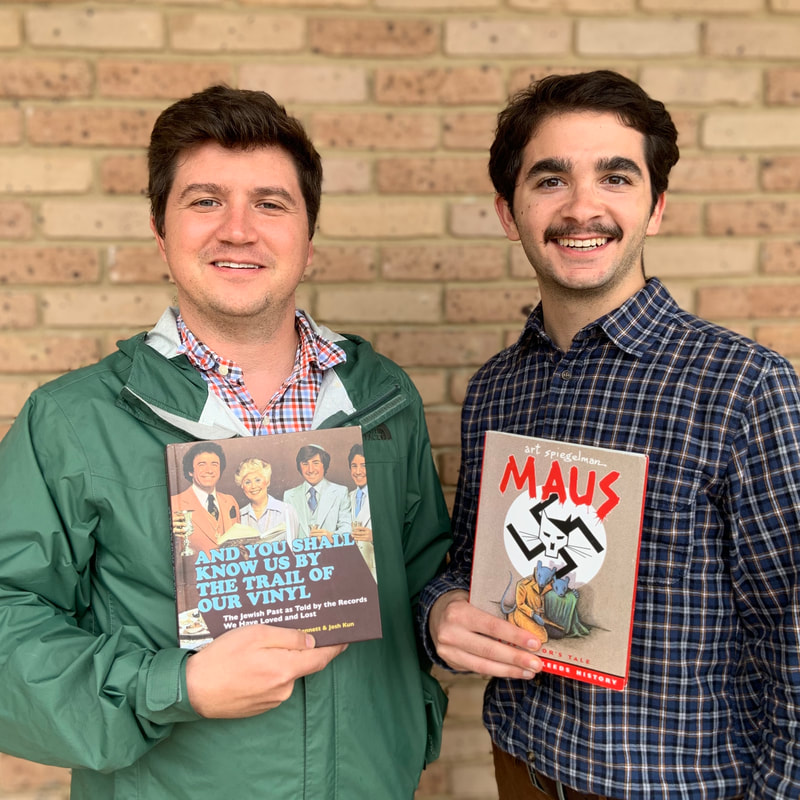Some Tales from Two JoshesBy ISJL Education Isaac Gamoran
Here at the ISJL, we are graced with the serious good fortune of having not one but two Joshess in the office! Josh Parshall is the head of our History Department, while Josh Altshuler is one of our 2018-2020 Education Fellows. Besides sharing a name, and a great sense of humor, these two have one major passion in common: a love of books. Sine it’s Jewish Book Month, we thought there may never be a better time to highlight these two humans, and give both of them a chance to share their expertise with all of you! This article provides a firsthand take on their respective answers to my question, “What books or genre of books should religious school classrooms give a second glance?” From Jewish graphic novels to cookbooks and comedy albums, the ISJL received all sorts of inspiring ideas. Read below to find out what those possibilities are! An Altshuler Addition to the Classroom Education Fellow Josh Altshuler emphasized one genre often overlooked that need not be ignored: Jewish graphic literature and memoirs. He believes that this medium offers a fresh supplement to religious school lessons and warrants special attention. The Jewish graphic novel is a niche subject that was born out of the comic book industry during the early twentieth century. In the 1930s, at a time when Jews experienced challenges finding employment, the comic book industry was one setting where folks found opportunity. Jews like Superman creators Jerry Siegel and Joe Shuster, Batman creators Bob Kane and Bill Finger, and Marvel mastermind Stan Lee set the stage for those to come. Starting in the 1970s, an innovative medium, known as the graphic memoir, surfaced out of the comic book. There have been many fantastic Jewish graphic works since 1970, but there are three that are most practical to the classroom: Will Eisner’s A Contract with God, Art Spiegelman’s Pulitzer Prize-winning Maus, and Harvey Pekar’s American Splendor. These three texts pinpoint important aspects of this medium that can be discussed in class. A Contract with God was the first graphic memoir (and coincidentally, the first Jewish graphic memoir), and references Jewish immigration to America and a personal dilemma with God. Maus gave legitimacy to a growing medium of graphic narratives and launched a new approach to documenting trauma. Spiegelman’s work explores his father’s memories of the Holocaust and his own identity as a “survivor of survivors.” Finally, American Splendor, an autobiographical comic book anthology from 1976-2008, details the mundane life experiences of Pekar as an American Jew on the streets of Cleveland. All three graphic pieces present perspectives on life as a Jew in America and greatly enhance the classroom experience for eighth graders and high schoolers. Note: These memoirs do contain mature themes and content! So, the real question is, why does this genre matter to Jewish education today? As Altshuler so eloquently puts it: “The graphic memoir is becoming a new way of communicating the influence of the past and complexes of identity […] and as we think about the books that we teach kids and adults, this medium is one way that we can build stronger connections to text. Sometimes we get lost in words alone, but bringing words and pictures together in tandem is a new way to experience Judaism and build engagement for teachers and students.” Parshall’s Three Thoughts Moving on from one Josh to the next: Dr. Josh Parshall is the Director of the ISJL History Department and keeper of the ISJL’s Encyclopedia of Southern Jewish Communities. In response to my question about books, after a long, contemplative pause, Parshall whipped out three spectacular titles that he believes could and should be on a religious school’s radar.
Hopefully, the ideas from each ISJL Josh will help spice up the classroom book shelf with alternative titles and poignant stories! Happy reading y’all! |
- Home
- WHO WE ARE
-
WHAT WE DO
- PODCAST
- Conference >
- Education >
-
CULTURE
>
- Culture Overview
- Cultural Programming >
-
History
>
-
Encyclopedia of Southern Jewish Communities
>
- Alabama Encyclopedia
- Arkansas Encyclopedia
- Georgia Encyclopedia
- Florida Encyclopedia
- Kentucky Encyclopedia
- Louisiana Encyclopedia
- Mississippi Encyclopedia
- North Carolina Encyclopedia
- Oklahoma Encyclopedia
- South Carolina Encyclopedia
- Tennessee Encyclopedia
- Texas Encyclopedia
- Virginia Encyclopedia
- Encyclopedia Credits
- Oral History
-
Encyclopedia of Southern Jewish Communities
>
- SPIRITUALITY >
- DONATE
- Shalom Y'all
- Strategic Plan
- Southern & Jewish Blog
- Calendar
- Virtual Press Kit
|
©2024 Goldring/Woldenberg Institute of Southern Jewish Life
|

